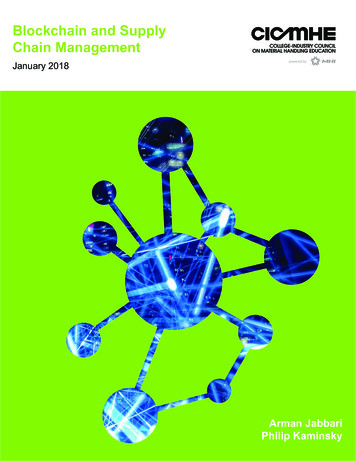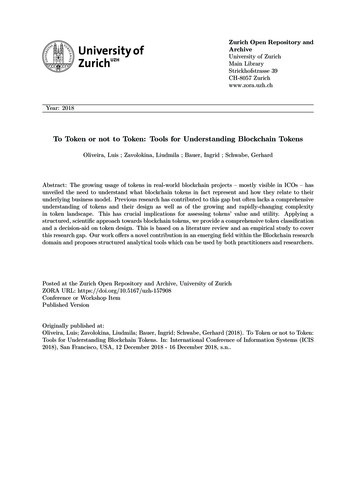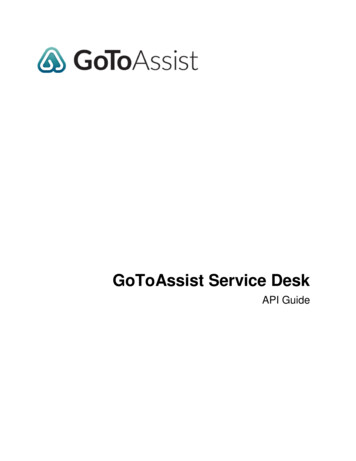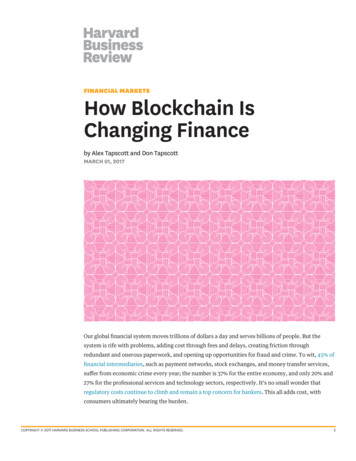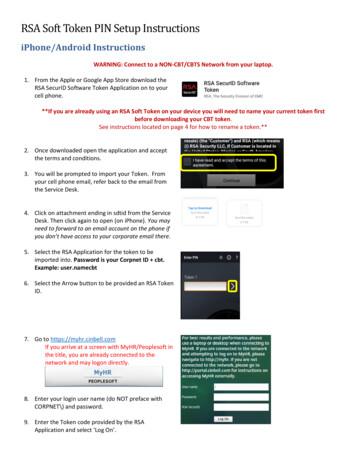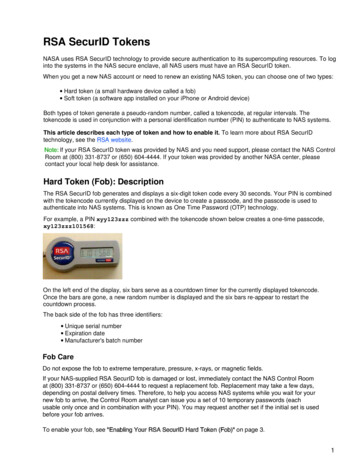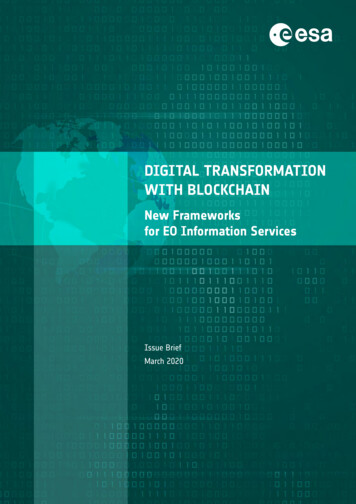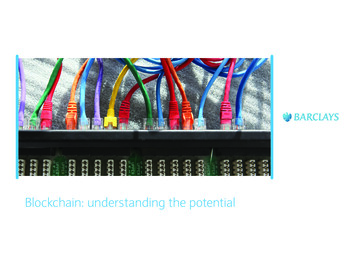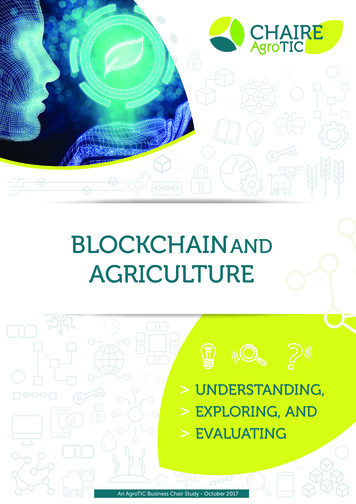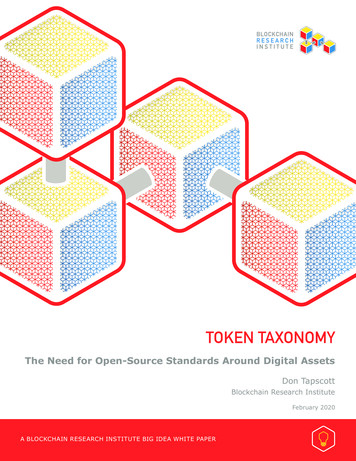
Transcription
TOKEN TAXONOMYThe Need for Open-Source Standards Around Digital AssetsDon TapscottBlockchain Research InstituteFebruary 2020A BLOCKCHAIN RESEARCH INSTITUTE BIG IDEA WHITE PAPER
Realizing the new promise of the digital economyIn 1994, Don Tapscott coined the phrase, “the digital economy,” with hisbook of that title. It discussed how the Web and the Internet of informationwould bring important changes in business and society. Today the Internetof value creates profound new possibilities.In 2017, Don and Alex Tapscott launched the Blockchain Research Instituteto help realize the new promise of the digital economy. We research thestrategic implications of blockchain technology and produce practicalinsights to contribute global blockchain knowledge and help our membersnavigate this revolution.Our findings, conclusions, and recommendations are initially proprietary toour members and ultimately released to the public in support of our mission.To find out more, please visit www.blockchainresearchinstitute.org.Blockchain Research Institute, 2020Except where otherwise noted, this work is copyrighted 2020 by theBlockchain Research Institute and licensed under the Creative CommonsAttribution-NonCommercial-NoDerivatives 4.0 International Public License.To view a copy of this license, send a letter to Creative Commons, POBox 1866, Mountain View, CA 94042, USA, or visit e.This document represents the views of its author(s), not necessarily thoseof Blockchain Research Institute or the Tapscott Group. This material is forinformational purposes only; it is neither investment advice nor managerialconsulting. Use of this material does not create or constitute any kind ofbusiness relationship with the Blockchain Research Institute or the TapscottGroup, and neither the Blockchain Research Institute nor the Tapscott Groupis liable for the actions of persons or organizations relying on this material.Users of this material may copy and distribute it as is under the terms ofthis Creative Commons license and cite it in their work. This document maycontain material (photographs, figures, and tables) used with a third party’spermission or under a different Creative Commons license; and users shouldcite those elements separately. Otherwise, we suggest the following citation:Don Tapscott, “Token Taxonomy: The Need for Open-SourceStandards Around Digital Assets,” Blockchain Research Institute,19 Feb. 2020.To request permission for remixing, transforming, building uponthe material, or distributing any derivative of this material forany purpose, please contact the Blockchain Research act-us, and put“Permission request” in subject line. Thank you for your interest!
ContentsIdea in brief3Tokens and digital assets3The state of the token3First-principles thinking5Introducing the Token Taxonomy Framework6Characteristics of tokens9Types of tokens11Behaviors and property sets of tokens12Benefits of shared token standards14Ease of use14Interoperability15Communication16Security and speed17Our role in co-creating standards18The need for collaboration18The need for stewardship19The need for certification20Conclusions21About the author22About the Blockchain Research Institute23Notes24
TOKEN TAXONOMYIdea in brief» Digital assets, sometimes called tokens, are poorlyunderstood. That may be why they are used to describe avariety of things, some of which are contradictory. We knowthat they are important, but we need greater concurrence onwhat they are and how we define them in terms of code.» The Token Taxonomy Initiative (TTI) is a new standardizationeffort championed by a who’s who of enterprise blockchain,from Accenture to Web3 Labs.1 It will help unify ourunderstanding of the token economy without sacrificing thedecentralization that makes it so powerful.» The TTI’s Token Taxonomy Framework (TTF) is a firstWe know that digital assetsare important, but we needgreater concurrence onwhat they are and how wedefine them in terms ofcode.principles model for understanding tokens. It starts withtoken types and progresses to token properties, with a goal ofenabling anyone—technologist, businessperson, or regulator—to understand what is happening and how to take part intoken projects.» Standardization requires a commitment to collaboratingwith competitors, stewarding shared creations faithfully, anddeveloping certification programs that make it easier for usersto detect fakes and harder for unscrupulous designers to claimthe use of standards while deviating from those standards.» The benefits of shared token standards are many: increasedease of use, improved interoperability, easier communication,and faster and more secure development of the token projectsthat we’d like to see in the world.Tokens and digital assetsThe state of the tokenFew concepts are more widely discussed and poorly understood intoday’s blockchain world than the token. The world seems to knowthat tokens are important, but little else; the word token is used inmyriad ways today, many of which conflict.3 2020 BLOCKCHAIN RESEARCH INSTITUTE
TOKEN TAXONOMYPerhaps the most commonmodern usage of tokenis as the latter part ofwhat some call “securitytokens,” by which theymean cryptocurrencies thatgovernments are justifiedin regulating.Perhaps the most common modern usage of token is as the latterpart of what some call “security tokens,” by which they meancryptocurrencies that governments are justified in regulating.Security tokens are the ostensible antithesis of “utility tokens,” bywhich crypto enthusiasts mean cryptocurrencies that governmentsshould not clamp down on—especially the ones they’re developingfor their blockchains.2 The precise details of the possible differencebetween a utility token and a security token is irrelevant. Whatmatters is that this use of the word token strongly implies thattokens are tantamount to cryptocurrencies, and that the polarextremes of “security” and “utility” are complementary halves of acollective whole.One of the largest issues facing the blockchain community in thebeginning of 2019 was the US Securities and Exchange Commission’sruling that some cryptocurrency sales—most often branded as initialcoin offerings (ICOs)—constituted unlicensed sales of securities.3 Itwas an unspoken truth that most ICOs in the 2017 boom met thedefinition of a security. A few SEC indictments later, coin holdersfound themselves furiously tweeting and publishing Medium postsabout their “utility tokens” to distance themselves from such coins.Other recent uses of the word token, however, have little to do withcryptocurrencies. The phrase “non-fungible token” entered theblockchain lexicon with the emergence of an improvement ticket forthe Ethereum mainnet that defined a standard for tokens (ERC-721)that represented unique, one-of-a-kind items.4 The classic example,of course, is the game CryptoKitties, in which users collect, trade,and breed digital cat images. One ether is just like the other (except,perhaps, for their transactional histories), but each CryptoKitty isunique and owned by only one wallet.5 That’s a far cry from digitalmoney—but the CryptoKitty also received a token label.Belgium Antwerp Shipping Container Freight Cargo by Olaf (olafpictures), 2012,used under Pixabay license, accessed 27 Jan. 2020.4 2020 BLOCKCHAIN RESEARCH INSTITUTE
TOKEN TAXONOMYThe different interpretationsand uses of the word tokenare many, varied, andcollectively confusing.Both of the above uses are fairly standard and accepted as correctby the blockchain intelligentsia—but, as we know from practice andthe still unneutralized force of entropy, there are far more waysto be wrong than right. Some folks have disparate and seeminglycontradictory names for different types of tokens (e.g., work token,use token, investment token, asset token, payment token, etc.);others use token when they really mean contract. Marley Gray, chairof the Token Taxonomy Initiative, Enterprise Ethereum Alliance boardmember, and principal architect at Microsoft, said:It’s tempting to put contract logic within your token. It wouldbe like saying, “I’m going to create a token for a property titleand I’m going to put the information and the logic for how itshould be paid in the token itself.” That essentially makes yourtoken nonreusable, because it has contract logic embeddedwithin it that may not apply to the next sale of the title.Just as we don’t write our mortgages on the actual moneywe’re paying them with, because we need to reuse thatmoney, we don’t want to do that [with tokens].6What’s more, an equal number of folks draw a bright line betweentoken and coin as those who draw no distinction at all; some believethat tokens can exist only on a public blockchain whereas others aremore permissive; and the list goes on.The different interpretations and uses of the word token are many,varied, and collectively confusing. How should any interested outsiderhope to build up a coherent definition of a token with so muchcontradictory information flying about?First, we can acknowledge that tokens are incredibly important tothe blockchain world. Nearly every introductory blockchain articledives into its own definition of the concept early on, as tokens areamong the building blocks of blockchain technology. Second, as acommunity, we must align on what we mean by token if we hope toexplain blockchain to the average consumer.First-principles thinkingAs a community, we mustalign on what we mean bytoken if we hope to explainblockchain to the averageconsumer.In the face of such complexity, diving deeper into the weeds (e.g., byisolating what constitutes a security) isn’t useful. Instead, let’s attackthe problem from a different angle—preferably one that starts withfirst principles.In 2001, newly minted millionaire Elon Musk had a goal to makehumanity a multi-planetary species, and a way to get us there: MarsOasis. Doug Bierend, writing for Vice, explained the mission:A small lander carrying a glass-enclosed greenhouse wouldbe launched to the surface [of Mars]. Seeds embedded indehydrated nutrient gels would activate when the little landertouched down, sending back images and data as the leafycargo grew and died on the planet’s surface. It could reveala lot about the viability of transporting life to Mars andsustaining it there—a worthy experiment indeed.75 2020 BLOCKCHAIN RESEARCH INSTITUTE
TOKEN TAXONOMYMusk wanted to excite the public and spur government investmentby showing green plant life growing against a red backdrop. Therewas only one problem: rocket launches for such an experiment wereprohibitively expensive. The cheapest launch vehicles NASA couldoffer were about 65 million; that price tag alone was triple Musk’santicipated budget for the entire experiment. After exploring otheroptions (at one point even asking Russia to sell him an old ICBM),he found nothing in the known universe that could achieve the pricepoint he needed.8That would have been the end of the story for most people. ButMusk is not most people. Using first principles thinking, he disputedthe necessity of the constraints the world imposed upon him. In aninterview with Kevin Rose, Musk said:I think it’s important to reason from first principles ratherthan by analogy. The normal way we conduct our lives iswe reason by analogy. We are doing this because it’s likesomething else that was done, or it is like what other peopleare doing. Slight iterations on a theme. It’s mentally easier. Launched in April 2019,the Token TaxonomyFramework (TTF) is anattempt to make sense oftokens by going back tofirst principles.First principles is a physics way of looking at the world.What that really means is you boil things down to the mostfundamental truths and then reason up from there. Thattakes a lot more mental energy.9Applying first-principles thinking to the cost of a rocket, Muskconcluded that the market was underperforming relative to whatwas physically possible. He discovered that the cost of raw materialsneeded to construct a rocket is just around two percent of the totalcost, which meant that he had an opportunity to build rockets morecheaply.10 Recognizing an opportunity to carry on the mission of MarsOasis, he founded SpaceX shortly thereafter.11Introducing the Token TaxonomyFrameworkLaunched in April 2019, the Token Taxonomy Framework (TTF) is anattempt to make sense of tokens by going back to first principles.In early November 2019, a wide-spanning group of blockchainorganizations that included the core players in enterpriseblockchain—Accenture, Adhara, Banco Santander, Clearmatics,ConsenSys, Digital Asset, Envision Blockchain, EY, HederaHashgraph, IBM, Intel, ioBuilders, Itau, J.P.Morgan, Komgo, Microsoft,R3, Web3 Labs, and members of the Enterprise Ethereum Alliance,among others—released the TTF Version 1.0 as the first output ofthe Token Taxonomy Initiative, an independent organization hostedby the Enterprise Ethereum Alliance (EEA).12 Ron Resnick, executivedirector of the EEA and a major proponent of the initiative, explained:6 2020 BLOCKCHAIN RESEARCH INSTITUTE
TOKEN TAXONOMY“There needs to be someuniversal language orframework of how tokensare defined and utilizedthat’s flexible, adaptable,and expandable to be usedfor the myriad use casesthat will emerge.”RON RESNICKExecutive DirectorEnterprise EthereumAllianceThe Token Taxonomy Framework deals with how digitalassets are exchanged and how we can accomplish globaladoption of digital assets. In order for such assets to beinteroperable as deployed by developers, and for oversightexchanges by governments and regulators to be implementedin the most efficient manner, there needs to be some modelfor how they all communicate using the same terminology,the same language, and in a way that allows oversight andaccountability.There needs to be some universal language or framework ofhow tokens are defined and utilized that’s flexible, adaptable,and expandable to be used for the myriad use cases thatwill emerge. That’s the vision. It’s really simple: the globaleconomy of the future is going to be a tokenized economy;and for that to happen, we have to define tokens in aconsistent way.13That’s a grand vision, but the TTF appears to be up to the task. Webelieve that it’s a truly impressive work that should prove to be anindustry-altering standard, as long as the community continues toengage and develop it.Boxes Drawers Mailboxes Residential Mailboxes Wood by Pexels, 2016, usedunder Pixabay license, accessed 27 Jan. 2020.The TTF includes a set of core concepts and terms, with which youcan intuitively understand and technically describe existing tokenprojects; a composition framework that helps you build new kindsof tokens from the ground up; examples and real-world tokenspecifications with portable, compartmentalized definitions of tokensfor a variety of extant use cases; and much more.7 2020 BLOCKCHAIN RESEARCH INSTITUTE
TOKEN TAXONOMYNote that Ethereum and other technology platforms are not on thatlist. The TTF is intentionally platform-agnostic and doesn’t even takesides on blockchains versus databases. Paul DiMarzio, director ofcommunity for the EEA, said:The Token TaxonomyFramework is intentionallyplatform-agnostic anddoesn’t even take sideson blockchains versusdatabases.With the TTF, there’s a difference between specification andimplementation. We only focus on the specification part of it.We want to make sure that every token has a common andconsistent set of behaviors and characteristics that are welldefined and well known and well understood. Once you getthat settled, then wherever you want to implement it, you’regoing to use whatever the rules and regulations are of thatparticular framework.We will provide sample code, so, for instance, if a memberis very much into the Ethereum space and they understandERC-20s really well, they may start to provide some samplesto how you would actually implement those specifications inERC-20. Fabric guys will do the same for their platform, and soon.14In other words, the framework is intended to be descriptive,not prescriptive. A team from the Coalition of Automated LegalApplications described the challenge well:Whenever engineers set out to develop a new standard tounite several competing standards, they succeed only inadding yet another standard. The current proliferation of chatprotocols perfectly illustrates this problem. iMessage, Signal,Telegram, Slack, Discord, WhatsApp, Messenger, Hangouts,Skype, WeChat or just plain SMS: it takes dozens of chatclients to communicate with everyone, and none of them arewilling to talk to each other.15“The Token TaxonomyFramework addresses theinterconnection problemfrom the top down,describing in a technologyneutral way how you canstandardize.”MARLEY GRAYChairToken Taxonomy InitiativeMarley Gray of TTI elaborated:The Token Taxonomy Framework addresses theinterconnection problem from the top down, describing in atechnology-neutral way how you can standardize. I’ve donelots of integration projects over my 30 years of experience inthe field, particularly at the blockchain or the data layer whereI’m connecting two different databases together, point topoint.It’s achievable and it’s doable, but it’s really brittle andjust extremely susceptible to minor changes on one endcompletely breaking your bridge between the two. So thosepoint-to-point connections are really hard to maintain overtime. The successful integration patterns that I’ve seen, andrepeatedly, are to abstract one level up to create the commonset.If you think about ODBC [open database connectivity]—how dowe allow applications that use relational databases not to have8 2020 BLOCKCHAIN RESEARCH INSTITUTE
TOKEN TAXONOMYto be specifically programmed for just an Oracle databaseor a SQL database—you can write it once and it should stillwork if you point it to any ODBC-compliant database. That is asuccessful integration, still around today.“Our chain-agnosticapproach allows businessesto focus on how to bestdefine, treat, or exchangedigital assets withoutworrying about potentiallimitations of a singleblockchain framework.”JONATHAN LEVIVice Chair, Token TaxonomyInitiativeCEO, HACERA, TheUnbounded NetworkWe did the same thing for printers. Back in the day, you wentand bought a printer and each application had to have a driverfor that program to be able to print to that printer, which wasa really horrible experience when you could go buy a brandnew printer and discover that WordPerfect wouldn’t print to it.That’s why we’re solving the problem by creating a commonabstraction, but not being so abstract where it completelyremoves any differences between those platforms and doesn’tlet the true capabilities shine.16The TTF is not just another standard, it’s a metastandard: somethingthat can stand above other interoperability protocols, remainagnostic on many of the contentious implementation questions thatother protocols squabble over, and describe (not prescribe) what’shappening so the rest of the world can make sense of the new tokeneconomy. Gray continued with a helpful analogy to drive home thispoint: the TTF is like the standardization of railroad track widths.The framework encourages learning and iterativeimprovement over time. First, it describes railroad tracks. Itdoes not say how wide they should be or any of the specifics.It just says these are railroad tracks. Railroad tracks servethis business purpose.You don’t specify how wide the tracks are until you put themin context with all of the other things that make them up .What’s the weight of the train? How fast is the train going totravel? But we won’t know those things until you get to that.Then when edits occur, you keep the historical record,because it’s using GitHub behind the scenes. You can say,“Oh, you know what, they did try the 42 inches rail widthbefore and they changed it to 60 and, oh, this is why.”17The TTF is an attempt todescribe tokens preciselyas they are today, withoutjudgment but with a morerobust structure.The TTF is an attempt to describe tokens precisely as they are today,without judgment but with a more robust structure. We will turnto the TTF’s structured approach to understanding how tokens arecomposed shortly, but first, we need to make sure we’re on commonground in understanding precisely what tokens are.Characteristics of tokensTokens may have different features and purposes, but all tokens haveseveral characteristics in common: they are valuable, representative,digital, distinct, and authentic.9 2020 BLOCKCHAIN RESEARCH INSTITUTE
TOKEN TAXONOMYRails Soft Gleise Railway Railway Line Train by Michael Gaida (MichaelGaida),2018, used under Pixabay license, accessed 27 Jan. 2020. Cropped to fit.First, tokens are valuable in the sense that we are usually able tovalue them (i.e., determine their value) in terms of a global standardsuch as the US dollar and within a context such as the Bitcoin orEthereum blockchain or a cryptocurrency exchange. For example,Bitcoin’s monetary policy ensures the scarcity of tokens within thesystem; and its use of cryptography and its proof-of-work consensusmechanism, which consumes a calculable amount of energy toappend blocks and mint bitcoins, make it very costly to steal existingcoins and difficult to hack otherwise. So bitcoin is valuable within thissystem and has value in the marketplace.18Second, tokens are representative in the sense that they stand forthe holder’s claims to an asset, resource, or right. Sometimes, tokensrepresent physical objects like artwork, gold, or land. Other times,tokens represent rights to digital goods and services like intellectualproperty, where tokens provide access to members-only content, useof a design patent, cloud computing, or a skin in Fortnite.19Sometimes, tokensrepresent physical objectslike artwork, gold, orland. Other times, tokensrepresent rights to digitalgoods and services likeintellectual property.Third, tokens are digital, often stored in digital wallets and recordedon a blockchain. While tokens could be representations of physicalobjects such as a deed to land or the title to an automobile, thedeeds and titles themselves are digital. We suppose that the physicalcoins your local coin-operated game room uses might also have aclaim to be tokens, but that’s not what we’re talking about here. Norare we talking about the security tokens stored on fobs and used toauthenticate identity or to open or close electronic locks.Fourth, tokens are discrete. We can verify the number of tokens;and we can distinguish one token from another, just as we candifferentiate one dollar bill from another. Tokens are not observerdependent: any honest audit should reveal that a token to you is thesame as a token to me. As you’ll see, this quality should also be trueof the traits and behaviors of a token. There should be no ambiguityin the token economy.10 2020 BLOCKCHAIN RESEARCH INSTITUTE
TOKEN TAXONOMYFifth, and perhaps most important, tokens are authentic; that is, weare able to verify their authenticity. In a human context, authenticityis an operationalized form of trust. As much as we love to use theword trustless in the blockchain world, we must remember that thewhole system works only if people believe that our tokens are as realas the paper money, license, or deed they hold in their hand.The final goal—trust—isthe real magic of the TTF.It’s a way for anyone andeveryone to speak thesame language.It may be verifiably and objectively true that a proof-of-work tokenis unforgeable—but if you go to a Fortune 500 chief executive todayand launch into a monologue on SHA-256, the Byzantine generals’problem, and UTXOs (unspent output from bitcoin transactions) toexplain why, you’re not going to leave that meeting with an additionalbudget allocation for your token project.How to build such trust and secure such investment is a much largerquestion, and one that touches on fundamental questions of how thepublic learns to trust new technologies. For the sake of this analysis,we’ll just say that, to convince people to trust something, you musthelp them to understand how it works or what it can do for them.(One of those two usually suffices; consider the complexity of jetpropulsion and our willingness to board planes nonetheless, becausewe can predict the engines will do us some good and not hurt us.)This final goal—trust—is the real magic of the TTF. It’s a way foranyone and everyone to speak the same language, understand whattokens are, and believe that these digital representations of valuablethings really do what the tech guys claim they can do.Types of tokensThe first major building block used by the TTF to describe tokensis what they call types: whether each instance of a token is uniqueor interchangeable. They call unique tokens non-fungible andinterchangeable tokens fungible. We’ve already introduced thisconcept above, but it bears repeating because it’s so fundamental—we all must understand this distinction to make sense of tokens.US dollars are fungible: trading 1 for 1 is trivial, because eachinstance of a dollar (each bill) is functionally equivalent to every otherinstance. Artwork is non-fungible: trading one painting for another isa nontrivial transaction because the value of even similar paintingsby the same artist will vary significantly.The TTF calls uniquetokens non-fungible andinterchangeable tokensfungible.11Interestingly, the TTF also builds on our understanding of fungibilityby proposing a third type of token: a hybrid. A hybrid, for example,is like a general admission concert ticket. Let’s say there’s a bigMetallica concert tomorrow, and you buy a general admission ticket.The ticket is fungible in terms of seating: you have to storm the gatesif you want a front row seat. But it’s non-fungible in relation to theother nights of the tour: if you miss the concert tomorrow, you can’tuse same ticket for the next day. We can think of such a concertticket as a fungible token for seating nested inside of a non-fungibletoken for concert date: a hybrid. 2020 BLOCKCHAIN RESEARCH INSTITUTE
TOKEN TAXONOMYBehaviors and property sets of tokensAfter defining the token type, the TTF progresses to token behaviorsand properties, or unique compositional elements. Ron Resnick,executive director of the EEA, explained these concepts through amusic analogy:Behaviors are rules forhow tokens behave—apermissible action orrestriction—and propertysets are data elements thata token must have.The language of music is simple. There are 12 notes and thereare rules for how you compose, but look at the complexitythat you can build—solutions, types, styles, and instrumentsare infinite. That’s how we should define tokens. We shouldhave rules of behavior for the tokens, rules of how we definetheir properties.We should all agree on those rules, and then it is very simplefor the folks who learn how to use the framework to shareit with the technology folks in their organizations, and thosefolks can decide what underlying technology they’ll use, whichcould be any resource as long as it conforms to the frameworkthat will be offered.20Behaviors are rules for how tokens behave—a permissible actionor restriction—and property sets are data elements that a tokenmust have. An example of a behavior is a singleton: a non-fungiblesingleton is a one-of-a-kind digital asset represented by a solitarytoken; it is indivisible. In contrast is the behavior divisible (withthe alias of subdividable, denoted by d), which defines how manyconstituent pieces a token can be split into (e.g., a dollar that can bedivided into 100 cents, or two decimal places to the right of zero).A property set is a descriptive value that doesn’t achieve anythingwithin the token system itself but has external meaning, like a stockkeeping unit (SKU) or a serial number.Ultimately, there are too many property sets and behaviors for us todo justice to them all here—plus, Resnick called the full list in versionone of the TTF “a work in progress.” The Token Taxonomy Initiativewelcomes feedback. Its organizers hope that its members will dreamup properties they haven’t yet included in the framework and thensubmit them to GitHub as pull requests.21The Token TaxonomyInitiative welcomesfeedback.Emoney token specThe following example, adapted from a token spec called“Emoney” by Julio Faura from Adhara and Daniel Lehrner fromioBuilders, is a set of behaviors that describe a token that actslike money. Can you think of any behaviors that you could addto this list to make the token perform differently?»12Roles that are definable and assignable: This behaviorallows users to define which role(s) to create and whichbehavior(s) to assign to each role in the templatedefinition. It enables users to check whether other usershave the role and the authority to invoke whateverbehavior they’re invoking. Think of the different decision 2020 BLOCKCHAIN RESEARCH INSTITUTE
TOKEN TAXONOMYrights of the different roles of a company’s executive teamand its corporate board, all defined by the company’scharter.To make a token behavelike money, it must haveroles that are definable andassignable and �Burnable»Mintable»Delegable: A token class that implements this behaviorallows token owners to delegate certain behaviors to otherparties or accounts, that may invoke these behaviors onbehalf of the owners. In other words, those other partiesor accounts may automatically perform the delegatedbehaviors (up to a certain allowance) without seekingpermission.»Transferable: Every token has an owner. The transferablebehavior enables the owner to transfer ownership ofthe token to another party or account. This behavior isoften implied by other behaviors that might exist (e.g.,redeemable, sellable, etc.). This behavior is delegable.»Holdable: Every token has an owner. A hold specifies apayer, a
In 2017, Don and Alex Tapscott launched the Blockchain Research Institute to help realize the new promise of the digital economy. We research the strategic implications of blockchain technology and produce practical insights to contribute global blockchain knowledge and he
